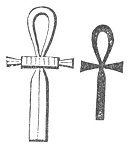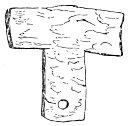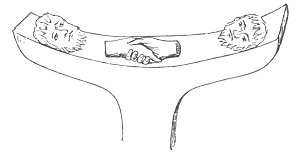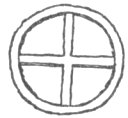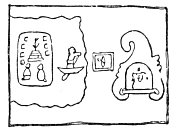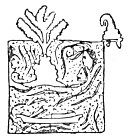Portolan chart allegedly as used by Columbus. The Terrestrial Paradise or Garden of Eden is to the West of the Mediterranean and surrounded in concentric circular walls of different compositions and representing the orbits of the different planets using their astrological references to the planets (Sun=gold, moon=silver, Venus=copper, etc)
Now despite the opinions stated in the last part of the examination of the Piri Reis Map, the
circle-cross and circle-t maps were in fact long established as conventionalised maps of Atlantis under the guise of the Original Homeland, the Garden of Eden and the Terrestrial Paradise. Such representations definitely trace all the way back to the beginning of Ancient Egypt.To quote extensively from Donnelly's Atlanntis the Antediluvian World on the topic:
Which does go to show that the circle-cross world view is a transposition of the symbol for Atlantis as an island in the middle of the "River Ocean" into a repeated glyph meaning "Inhabited World" and it is part of the Atlantean cultural complex. But it is not a literal depiction of Atlantis as a whole it is a reference to two characteristic features of Atlantis: the main city or multi-walled enclosure (concentric circles symbol alreaduy known as reproduced throughout the area, both as an actual settlement plan and as a common Megalithic symbol) and the "Four Rivers" as representing the irrigated plain of Atlantis, whith the criss-cross plan denoted by a simple cross set to the four directions (also carried over into the plan of the main city, which was connected up to the irrigation and travel canal grid). And what is more, the symbol is traditionally connected to agricultural products (breads and cakes) with a religious purpose from Ancient Egypt on. Which is to say the plan had an agricultural connection and that the ritual observance had to do with Agriculture deriving from Atlantis. But since it is not a literal meaning to the shape it cannot have anything to do with Antarctica! The actual shape of Atlantis as depicted on the Ancient Sea Kings Maps was different and was more usually a rectangle ("Oblong" according to Plato)CHAPTER V.
THE PYRAMID, THE CROSS, AND THE GARDEN OF EDEN.
No fact is better established than the reverence shown to the sign of the Cross in all the ages prior to Christianity. We cannot do better than quote from an able article in the Edinburgh Review of July, 1870, upon this question:
"From the dawn of organized Paganism in the Eastern world to the final establishment of Christianity in the Western, the Cross was undoubtedly one of the commonest and most sacred of symbolical monuments; and, to a remarkable extent, it is so still in almost every land where that of Calvary is unrecognized or unknown. Apart from any distinctions of social or intellectual superiority, of caste, color, nationality, or location in either hemisphere, it appears to have been the aboriginal possession of every people in antiquity--the elastic girdle, so to say, which embraced the most widely separated heathen communities--the most significant token of a universal brotherhood, to which all the families of mankind were severally and irresistibly drawn, and by which their common descent was emphatically expressed, or by means of which each and all preserved, amid every vicissitude of fortune, a knowledge of the primeval happiness and dignity of their species. Where authentic history is silent on the subject, the material relics of past and long since forgotten races are not wanting to confirm and strengthen this supposition. Diversified forms of the symbol are delineated more or less artistically, according to the progress achieved in civilization at the period, on the ruined walls of temples and palaces, on natural rocks and sepulchral galleries, on the hoariest monoliths and the rudest statuary; on coins, medals, and vases of every description; and, in not a few instances, are preserved in the architectural proportions of subterranean
p. 318
as well as superterranean structures, of tumuli as well as fanes. The extraordinary sanctity attaching to the symbol, in every age and under every variety of circumstance, justified any expenditure incurred in its fabrication or embellishment; hence the most persistent labor, the most consummate ingenuity, were lavished upon it. Populations of essentially different culture, tastes, and pursuits--the highly-civilized and the demi-civilized, the settled and nomadic--vied with each other in their efforts to extend the knowledge of its exceptional import and virtue among their latest posterities. The marvellous rock-hewn caves of Elephanta and Ellora, and the stately temples of Mathura and Terputty, in the East, may be cited as characteristic examples of one laborious method of exhibiting it; and the megalithic structures of Callernish and Newgrange, in the West, of another; while a third may be instanced. in the great temple at Mitzla, 'the City of the Moon,' in Ojaaca, Central America. also excavated in the living rock, and manifesting the same stupendous labor and ingenuity as are observable in the cognate caverns of Salsette--of endeavors, we repeat, made by peoples as intellectually as geographically distinct, and followers withal of independent and unassociated deities, to magnify and perpetuate some grand primeval symbol. . . .
"Of the several varieties of the Cross still in vogue, as national or ecclesiastical emblems, in this and other European states, and distinguished by the familiar appellations of St. George, St. Andrew, the Maltese, the Greek, the Latin, etc., etc., there is not one among them the existence of which may not be traced to the remotest antiquity. They were the common property of the Eastern nations. No revolution or other casualty has wrought any perceptible difference in their several forms or delineations; they have passed from one hemisphere to the other intact; have survived dynasties, empires, and races; have been borne on the crest of each successive wave of Aryan population in its course toward the West; and, having been reconsecrated in later times by their lineal descendants, are still recognized as military and national badges of distinction. . . .
"Among the earliest known types is the crux ansata, vulgarly called 'the key of the Nile,' because of its being found sculptured or otherwise represented so frequently upon Egyptian and Coptic monuments. It has, however, a very much older and more sacred signification than this. It was the symbol of
p. 319
symbols, the mystical Tau, 'the bidden wisdom,' not only of the ancient Egyptians but also of the Chaldeans, Phœnicians, Mexicans, Peruvians, and of every other ancient people commemorated in history, in either hemisphere, and is formed very similarly to our letter T, with a roundlet, or oval, placed immediately above it. Thus it was figuredon the gigantic emerald or glass statue of Serapis, which was transported (293 B.C.) by order of Ptolemy Soter from Sinope, on the southern shores of the Black Sea, re-erected within that famous labyrinth which encompassed the banks of Lake Mœris, and destroyed by the victorious army of Theodosius (A.D. 389), despite the earnest entreaties of the Egyptian priesthood to spare it, because it was the emblem of their god and of 'the life to come.' Sometimes, as may be seen on the breast of an Egyptian mummy in the museum of the London University, the simple T only is planted on the frustum of a cone; and sometimes it is represented as springing from a heart; in the first instance signifying goodness; in the second, hope or expectation of reward. As in the oldest temples
EGYPTIAN TAU.and catacombs of Egypt, so this type likewise abounds in the ruined cities of Mexico and Central America, graven as well upon the most ancient cyclopean and polygonal walls as upon the more modern and perfect examples of masonry; and is displayed in an equally conspicuous manner upon the breasts of innumerable bronze statuettes which have been recently disinterred from the cemetery of Juigalpa (of unknown antiquity) in Nicaragua."
CROSS ROM THE MONUMENTS OF PALENQUE.
When the Spanish missionaries first set foot upon the soil of America, in the fifteenth century, they were amazed to find the Cross was as devoutly worshipped by the red Indians as by themselves, and were in doubt whether to ascribe the fact to the pious labors of St. Thomas or to the cunning device of the Evil One. The hallowed symbol challenged their attention
p. 320on every hand and in almost every variety of form. It appeared on the bass-reliefs of ruined and deserted as well as on those of inhabited palaces, and was the most conspicuous ornament in the great temple of Gozumel, off the coast of Yucatan. According to the particular locality, and the purpose which it served, it was formed of various materials--of marble and gypsum in the open spaces of cities and by the way-side; of wood in the teocallis or chapels on pyramidal summits and in subterranean sanctuaries; and of emerald or jasper in the palaces of kings and nobles.
ANCIENT IRISH CROSS.
When we ask the question how it comes that the sign of the Cross has thus been reverenced. from the highest antiquity by the races of the Old and New Worlds, we learnthat it is a reminiscence of the Garden of Eden, in other words, of Atlantis.
CENTRAL AMERICAN CROSS
Professor Hardwicke says:
"All these and similar traditions are but mocking satires of the old Hebrew story--jarred and broken notes of the same strain; but with all their exaggerations they intimate how in the background of man's vision lay a paradise of holy joy--a paradise secured from every kind of profanation, and madeinaccessible to the guilty; a paradise full of objects that were calculated to delight the senses and to elevate the mind a paradise that granted to its tenant rich and rare immunities, and that fed with its perennial streams the tree of life and immortality."
COPPER COIN--TEOTIHUACAN.
To quote again from the writer in the Edinburgh Review, already cited:
p. 321
"Its undoubted antiquity, no less than its extraordinary diffusion, evidences that it must have been, as it may be said to be still in unchristianized lands, emblematical of some fundamental doctrine or mystery. The reader will not have failed to observe that it is most usually associated with water; it was 'the key of the Nile,' that mystical instrument by means of which, in the popular judgment of his Egyptian devotees, Osiris produced the annual revivifying inundations of the sacred stream; it is discernible in that mysterious pitcher or vase portrayed on the brazen table of Bembus, before-mentioned, with its four lips discharging as many streams of water in opposite directions; it was the emblem of the water-deities of the Babylonians in the East and of the Gothic nations in the West, a
well as that of the rain-deities respectively of the mixed population in America. We have seen with what peculiar rites the symbol was honored by those widely separated races in the western hemisphere; and the monumental slabs of Nineveh, now in the museums of London and Paris, show us how it was similarly honored by the successors of the Chaldees in the eastern. . . .
"In Egypt, Assyria, and Britain it was emblematical of creative power and eternity; in India, China, and Scandinavia, of heaven and immortality; in the two Americas, of rejuvenescence and freedom from physical suffering; while in both hemispheres it was the common symbol of the resurrection, or 'the sign of the life to come;' and, finally, in all heathen communities,
p. 322
without exception, it was the emphatic type, the sole enduring evidence, of the Divine Unity. This circumstance alone determines its extreme antiquity--an antiquity, in all likelihood, long antecedent to the foundation of either of the three great systems of religion in the East. And, lastly, we have seen how, as a rule, it is found in conjunction with a stream or streams of water, with exuberant vegetation, and with a bill or a mountainous region--in a word, with a land of beauty, fertility, and joy. Thus it was expressed upon those circular and sacred cakes of the Egyptians, composed of the richest materials-of flour, of honey, of milk--and with which the serpentand bull, as well as other reptiles and beasts consecrated to the service of Isis and their higher divinities, were daily fed; and upon certain festivals were eaten with extraordinary ceremony by the people and their priests. 'The cross-cake,' says Sir Gardner Wilkinson, 'was their hieroglyph for civilized land;' obviously a land superior to their own, as it was, indeed, to all other mundane territories; for it was that distant, traditional country of sempiternal contentment and repose, of exquisite delight and serenity, where Nature, unassisted by man, produces all that is necessary for his sustentation."
CROSS FROM EGYPTIAN MONUMENTS.
And this land was the Garden of Eden of our race. This was the Olympus of the Greeks, whereIn the midst of it was a sacred and glorious eminence--the umbilicus orbis terrarum--[The Omphalos]"toward which the heathen in all parts of the world, and in all ages, turned a wistful gaze in every act of devotion, and to which they hoped to be admitted, or, rather, to be restored, at the close of this transitory scene." "This same mild season gives the blooms to blow,
The buds to harden and the fruits to grow."
In this "glorious eminence" do we not see Plato's mountain in the middle of Atlantis, as he describes it:
"Near the plain and in the centre of the island there was a mountain, not very high on any side. In this mountain there dwelt one of the earth-born primeval men of that country,
p. 323
whose name was Evenor, and he had a wife named Leucippe, and they had an only daughter, who was named Cleito. Poseidon married her. He enclosed the hill in which she dwelt all around, making alternate zones of sea and land, larger and smaller, encircling one another; there were two of land and three of water . . . so that no man could get to the island. . . . He brought streams of water under the earth to this mountain-island, and made all manner of food to grow upon it. This island became the seat of Atlas, the over-king of the whole island; upon it they built the great temple of their nation; they continued to ornament it in successive generations, every king surpassing the one who came before him to the utmost of his power, until they made the building a marvel to behold for size and beauty. . . . And they had such an amount of wealth as was never before possessed by kings and potentates--as is not likely ever to be again."
The gardens of Alcinous and Laertes, of which we read in Homeric song, and those of Babylon, were probably transcripts of Atlantis. "The sacred eminence in the midst of a 'superabundant, happy region figures more or less distinctly in a]most every mythology, ancient or modern. It was the Mesomphalos of the earlier Greeks, and the Omphalium of the Cretans, dominating the Elysian fields, upon whose tops, bathed in pure, brilliant, incomparable light, the gods passed their days in ceaseless joys."
"The Buddhists and Brahmans, who together constitute nearly half the population of the world, tell us that the decussated figure (the cross), whether in a simple or a complex form, symbolizes the traditional happy abode of their primeval ancestors--that 'Paradise of Eden toward the East,' as we find expressed in the Hebrew. And, let us ask, what better picture, or more significant characters, in the complicated alphabet of symbolism, could have been selected for the purpose than a circle and a cross: the one to denote a region of absolute purity and perpetual felicity; the other, those four perennial streams that divided and watered the several quarters of it?" (Edinburgh Review, January, 1870.)
And when we turn to the mythology of the Greeks, we find
p. 324
that the origin of the world was ascribed to Okeanos, the ocean, The world was at first an island surrounded by the ocean, as by a great stream:
"It was a region of wonders of all kinds; Okeanos lived there with his wife Tethys: these were the Islands of the Blessed, the gardens of the gods, the sources of nectar and ambrosia, on which the gods lived. Within this circle of water the earth lay spread out like a disk, with mountains rising from it, and the vault of heaven appearing to rest upon its outer edge all around." (Murray's "Manual of Mythology," pp. 23, 24, et seq.)
On the mountains dwelt the gods; they had palaces on these mountains, with store-rooms, stabling, etc.
"The Gardens of the Hesperides, with their golden apples, were believed to exist in some island of the ocean, or, as it was sometimes thought, in the islands off the north or west coast of Africa. They were far famed in antiquity; for it was there that springs of nectar flowed by the couch of Zeus, and there that the earth displayed the rarest blessings of the gods; it was another Eden." (Ibid., p. 156.)
Homer described it in these words:"It was the sacred Asgard of the Scandinavians, springing from the centre of a fruitful land, which was watered by four primeval rivers of milk, severally flowing in the direction of the cardinal points, 'the abode of happiness, and the height of bliss.' It is the Tien-Chan, 'the celestial mountain-land, . . . the enchanted gardens' of the Chinese and Tartars, watered by the four perennial fountains of Tychin, or Immortality; it is the hill-encompassed Ilá of the Singhalese and Thibetians, 'the everlasting dwelling-place of the wise and just.' It is the Sineru of the Buddhist, on the summit of which is Tawrutisa, the habitation of Sekrá, the supreme god, from which proceed the four sacred streams, running in as many contrary directions. "Stern winter smiles on that auspicious clime,
The fields are florid with unfading prime,
From the bleak pole no winds inclement blow.
Mould the round hail, or flake the fleecy snow;
But from the breezy deep the blessed inhale
The fragrant murmurs of the western gale."
p. 325
[paragraph continues] It is the Slávratta, 'the celestial earth,' of the Hindoo, the summit of his golden mountain Meru, the city of Brahma, in the centre of Jambadwípa, and from the four sides of which gush forth the four primeval rivers, reflecting in their passage the colorific glories of their source, and severally flowing northward, southward, eastward, and westward."
It is the Garden of Eden of the Hebrews:
"And the Lord God planted a garden eastward ["in front of"] Eden; and there he put the man whom he had formed. And out of the ground made the Lord God to grow every tree that is pleasant to the sight, and good for food; the tree of life also in the midst of the garden, and the tree of knowledge of good and evil. And a river went out of Eden to water the garden; and from thence it was parted, and became into four heads. The name of the first is Pison; that is it which compasseth the whole land of Havilah, where there is gold; and the gold of that land is good: there is bdellium and the onyx stone. And the name of the second river is Gihon: the same is it that compasseth the whole land of Ethiopia. And the name of the third river is Hiddekel: that is it which goeth toward the east of Assyria. And the fourth river is Euphrates. And the Lord God took the man and put him into the Garden of Eden to dress it and to keep it." (Gen. ii., 8-1-5.)
As the four rivers named in Genesis are not branches of any one stream, and head in very different regions, it is evident that there was an attempt, on the part of the writer of the Book, to adapt an ancient tradition concerning another country to the known features of the region in which be dwelt.
Josephus tells us (chap. i., p. 41), "Now the garden (of Eden) was watered by one river, which ran round about the whole earth, and was parted into four parts." Here in the four parts we see the origin of the Cross, while in the river running around the whole earth we have the wonderful canal of Atlantis, described by Plato, which was "carried around the whole of the plain," and received the streams which came down from the mountains. The streams named by Josephus would seem to represent the migrations of people from Atlantis to its colonies.
p. 356
[paragraph continues] "Phison," he tells us, "denotes a multitude; it ran into India; the Euphrates and Tigris go down into the Red Sea while the Geon runs through Egypt."
We are further told (chap. ii., p. 42) that when Cain, after the murder of. Abel, left the land of Adam, "he travelled over many countries" before be reached the land of Nod; and the land of Nod was to the eastward of Adam's home. In other words, the original seat of mankind was in the West, that is to say, in the direction of Atlantis. [The parallel myth from Ugarit/Ras Shamra says that Paradise is in the far west, in the direction of Sunset, which is what the Egyptians stated-DD]Wilson tells us that the Aryans of India believed that they originally came "from the West." Thus the nations on the west of the Atlantic look to the east for their place of origin; while on the east of the Atlantic they look to the west: thus all the lines of tradition converge upon Atlantis.
But here is the same testimony that in the Garden of Eden there were four rivers radiating from one parent stream. And these four rivers, as we have seen, we find in the Scandinavian traditions, and in the legends of the Chinese, the Tartars, the Singhalese, the Thibetians, the Buddhists, the Hebrews, and the Brahmans.
And not only do we find this tradition of the Garden of Eden in the Old World, but it meets us also among the civilized races of America. The elder Montezuma said to Cortez, "Our fathers dwelt in that happy and prosperous place which they called Aztlan, which means whiteness. . . . In this place there is a great mountain in the middle of the water which is called Culhuacan, because it has the point somewhat turned over toward the bottom; and for this cause it is called Culhuacan, which means 'crooked mountain.'" He then proceeds to describe the charms of this favored land, abounding in birds, game, fish, trees, "fountains enclosed with elders and junipers, and alder-trees both large and beautiful." The people planted "maize, red peppers, tomatoes, beans, and all kinds of plants, in furrows."
Here we have the same mountain in the midst of the water
p. 327
which Plato describes--the same mountain to which all the legends of the most ancient races of Europe refer.
The inhabitants of Aztlan were boatmen. (Bancroft's "Native Races," vol. v., p. 325.) E. G. Squier, in his "Notes on Central America," p. 349, says, "It is a significant fact that in the map of their migrations, presented by Gemelli, the place of the origin of the Aztecs is designated by the sign of water, Atl standing for Atzlan, a pyramidal temple with grades, and near these a palm-tree." This circumstance did not escape the attention of Humboldt, who says, I am astonished at finding a palm-tree near this teocalli. This tree certainly does not indicate a northern origin. . . . The possibility that an unskilful artist should unintentionally represent a tree of which he had no knowledge is so great, that any argument dependent on it hangs upon a slender thread." ("North Americans of Antiquity," p. 266.)
The Miztecs, a tribe dwelling on the outskirts of Mexico, had a tradition that the gods, "in the day of obscurity and darkness," built "a sumptuous palace, a masterpiece of skill, in which they male their abode upon a mountain. The rock was called 'The Place of Heaven;' there the gods first abode on earth, living many years in great rest and content, as in a happy and delicious land, though the world still lay in obscurity and darkness. The children of these gods made to themselves a garden, in which they put many trees, and fruit-trees, and flowers, and roses, and odorous herbs. Subsequently there came a great deluge, in which many of the sons and daughters of the gods perished." (Bancroft's "Native Races," vol. iii., p. 71.) Here we have a distinct reference to Olympus, the Garden of Plato, and the destruction of Atlantis.
And in Plato's account of Atlantis we have another description of the Garden of Eden and the Golden Age of the world:
"Also, whatever fragrant things there are in the earth, whether roots, or herbage, or woods, or distilling drops of flowers and fruits, grew and thrived in that land; and again the cultivated
p. 328
fruits of the earth, both the edible fruits and other species of food which we call by the name of legumes, and the fruits having a hard rind, affording drinks and meats and ointments . . . all these that sacred island, lying beneath the sun, brought forth in abundance. . . . For many generations, as long as the divine nature lasted in them, they were obedient to the laws, and well affectioned toward the gods, who were their kinsmen; for they possessed true and in every way great spirits, practising gentleness and wisdom in the various chances of life, and in their intercourse with one another. They despised everything but virtue, not caring for their present state of life, and thinking lightly of the possession of gold and other property, which seemed only a burden to them; neither were they intoxicated by luxury; nor did wealth deprive them of their self-control; but they were sober, and saw clearly that all these goods were increased by virtuous friendship with one another, and that by excessive zeal for them, and honor of them, the good of them is lost, and friendship perishes with them."
All this cannot be a mere coincidence; it points to a common tradition of a veritable land, where four rivers flowed down in opposite directions from a central mountain-peak. And these four rivers, flowing to the north, south, east, and west, constitute the origin of that sign of the Cross which we have seen meeting us at every point among the races who were either descended from the people of Atlantis, or who, by commerce and colonization, received their opinions and civilization from them.
.....
The Pyramid.--Not only are the Cross and the Garden of Eden identified with Atlantis, but in Atlantis, the habitation of the gods, we find the original model of all those pyramids which extend from India to Peru.
...
If the reader will turn to page 104 of this work he will see, in the midst of the picture of Aztlan, the starting-point of the Aztecs, according to the Botturini pictured writing, a pyramid with worshippers kneeling before it.
[This is another inverted map, South is the direction at the top. The man in the boat is coming to Mexico out of the East where the island is situated. The rectangle is comparable to the Europeran map's representations of Antillia and Plato's description of Atlantis as having an 'Oblong" shape-DD]
Fifty years ago Mr. Faber, in his "Origin of Pagan Idolatry," placed artificial tumuli, pyramids, and pagodas in the same category, conceiving that all were transcripts of the holy mountain which was generally supposed to have stood in the centre of Eden; or, rather. as intimated in more than one place by
p. 331
the Psalmist, the garden itself was situated on an eminence. (Psalms, chap. iii., v. 4, and chap. lxviii., vs. 15, 16, 18.)
The pyramid is one of the marvellous features of that problem which confronts us everywhere, and which is insoluble without Atlantis....
Schematic map illustrating Columbus' theory of sailing West to get to the Orient.
Below, reconstruction of First Map of Columbus.
Toscanelli, 1474, the original for the theory Columbus had about sailng West to go East.
Part of the problem that happened at this point was that a large rectangular island regularly shown in the Mid-Atlantic was suddenly identified as Japan (Cipangu) and thus the drawings which had been called Antillia before were now used to illustrate the more poorly-understood islands representing Japan. The confusion is remarked upon by Charles Hapgood in reference to the Piri Reis map in Maps of the Ancient Sea Kings and he provides this comparison chart:
Below, an earlier chart said to be used by Toscanelli as a source map
Below is one of the better presentations of the Maps of the Ancient Sea Kings idea incorporating the idea that Antillia on these maps represents an original Atlantis sea chart (Discussed on this blog earlier). The Atlantis version Maps of the Ancient Sea Kings charts seem to have been very accurate maps of the Mediterranean and slightly less accurate charts of Glaciated Northern Europe, plus apparently at least the Eastern shorelines of America in the mid-Atlantic states on South to Peru. At the same time there is a long tradition of the same conventionalised Eastern Asia as has been suggested to represent a Sundaland based set of Maps of the Ancient Sea Kings charts of the Ice Age coasts of the Far East. A more complete discussion of the matter follows in the sequel article coming up next.
One of the early charts representing "That Island", presumed by Firman
to be a representation of Ice-age Atlantis.
This map would be more complete by also incorporating the circle-city as part of the design, probably halfway along the coast and opposite to the straits of Gibralter. However we do have the documentation of that from other sources and it does not have to be shown on every map.

